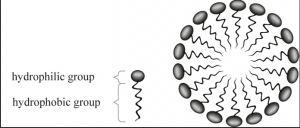Phospholipids
Phospholipids

Structurally, phospholipids are similar, yet distinct, from oils and fats.
Recall that the structure of a fat/triglyceride is based on three (3) fatty acid chains attached to a (3)-carbon glycerol backbone as shown below:

A phospholipid, in contrast, is constructed from (2) fatty acid chains attached to a (3) carbon glycerol backbone as shown below:
Instead of finding a 3rd fatty acid chain attached to the first carbon in the glycerol backbone (top left in the picture above), phospholipids contain a single ‘phosphate functional group’. This functional group contains a single phosphorous atom (P):

A key feature of this functional group is that it is attracted to water (a property termed “hydrophilic”; hydro = water + philic = loving).
When combined together, a phospholipid has the following structure:

Behavior of Phospholipids

A key distinguishing feature of a phospholipid, therefore, is that it has both a ‘hydrophilic‘ and a ‘hydrophobic’ (water-fearing) end. When phospholipids are mixed in water, they will naturally orient themselves so that the hydrophilic ends (the ‘head’) will point outward, facing the water while the hydrophobic ends (the ‘tails’) will tuck themselves inward forming a structure called a ‘micelle’. This automatic orientation is an important property used to form cell membranes which will be discussed later in the class.
Phospholipids
Structurally, phospholipids are similar, yet distinct, from oils and fats.
Biomolecule Structure
In the activity below, drag the appropriate biomolecule label on the right to label each structure correctly. When all labels have been placed correctly, you will be notified. To reset the activity, click the ‘reset’ button. (Note: you will see this activity several times as you work through this module; you will be able to practice as many times as necessary until you get all of the labels placed correctly)
From http://www.ontrack-media.net/biology/bm1l1drag2.html
Summary Lipids
- Lipids are water-insoluble molecules which can be categorized into several groups.
- The Phospholipids also contain fatty acid chains combined with glycerol, however, they also possess a ‘hydrophilic’ (water-loving) phosphate group attached to one end of the molecule
- The main function of Phospholipids is forming cellular membranes
- A phospholipid is constructed from (2) fatty acid chains attached to a (3) carbon glycerol backbone